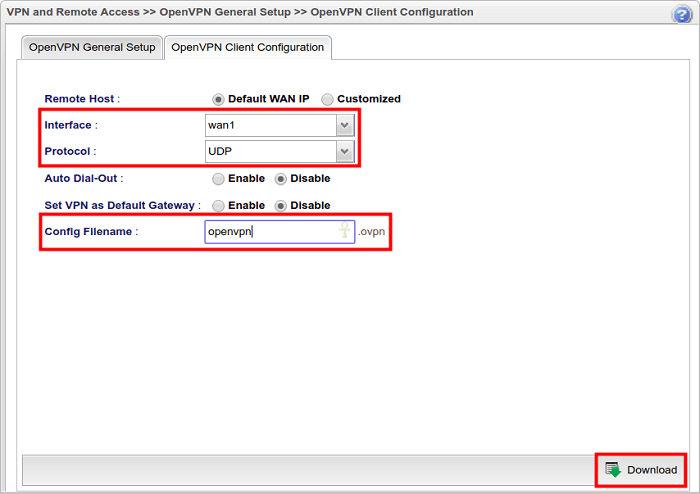- To import a client profile to an Android or iOS device: Install the OpenVPN Connect app. Open the email message that contains the.ovpn email attachment. Tap the attachment to open the file in the OpenVPN Connect app. Import the.ovpn file to the VPN client to create a new connection.
- Mar 16, 2021 The OpenVPN client v2 is called “OpenVPN Connect Client” and has been in use for many years. It is still available from our website and offered in the OpenVPN Access Server client web interface itself.
- Select Connect to connect to the VPN. Select the proper credentials, then select Continue. Once successfully connected, the icon will turn green and say Connected. To connect automatically. These steps help you configure your connection to connect automatically with Always-on. On the home page for your VPN client, select VPN Settings.
Loaded the Config file into OpenVPN Connect and set up the username/password. I get a 'Missing external certificate' notification on OpenVPN connect, but my understanding is that it's not needed for this instance, because my VPN on the NAS is a new enough version. After applying all these settings, I still don't get any access.
May 11, 2016 / Linux tutorialsWe read about how an OpenVPN Server can be setup and made ready to connect from an OpenVPN client in the article Configuring OpenVPN in Ubuntu using TUN/TAP
Let’s see how to set it up in a windows machine at home and how it can be used to connect to the OpenVPN server. I currently use a windows 8.1 machine. I will download the OpenVPN client from their official website. Since I use Windows 8.1, I will choose the exe file for windows installers ‘Installer (64-bit), Windows Vista and later’. Once downloaded, double click the exe and install the software. Unless you need to change it, the default OpenVPN installation path would be C:Program FilesOpenVPN
Please note that openvpn does not run on windows xp anymore. The operating systems for windows servers are for the windows 7 onwards only.
In order to setup the client, and start connecting to the server we first need to copy the following four files from the OpenVPN server.
- The sample client configuration file at /usr/share/doc/openvpn/examples/sample-config-files/client.conf
- The master CA certificate – ca.crt
- The client certificate generated in the server for my machine which I had named as clientname.crt
- The client key named clientname.key
If you have root access to the OpenVPN server, just issue the following commands and copy the contents from the shell directly.
In my windows client, now I will go to Start -> Search for notepad, right click and select ‘Run as administrator’. Then copy the contents of client.conf and save the file as C:Program FilesOpenVPNconfigclient.ovpn. You can choose whatever name you like for the file, but it is mandatory that it should end with the extension .ovpn so that OpenVPN can identify it as a config file. Create three new files, each for ca.crt, clientname.crt and clientname.key and save them also in C:Program FilesOpenVPNconfig folder. Make sure that the extension of the files read as .crt and .key and not .crt.txt or .key.txt
Open the client.ovpn file and make sure to place in the correct location the following files mentioned in the conf. In my case I placed them all in the same config folder as client.ovpn, hence I have not mentioned the full path to the files.
This will import file when you run the Openvpn.
In addition, you need to specify the OpenVPN server address below. You can either provide the hostname or the IP Address. 1194 is the default OpenVPN port.
Connecting to Server from your OpenVPN Client
The entire process has now finished and it is time to connect to the OpenVPN server from the client. Double click on the OpenVPN GUI shortcut which will be present in your Desktop after installation. You will notice a small computer icon with a lock in the system tray icon. Right click on it, and click ‘Connect’.
This way, OpenVPN access server, and you’re almost ready to go.
If more than one configs are present, it will list all the configs added in the OpenVPN Client config folder. Choose the one you want to connect and click ‘Connect’. If everything goes well, you will soon get a message that OpenVPN is connected. It will automatically assign a free internal IP to your machine as shown in the message below.
If you check your client machine’s shell, and issue an ‘ipconfig’ command you will see the new internal IP address listed there.

In addition, you would be able to ping the internal IP Addresses to and from the client. If it doesn’t respond, check your firewall settings.
Please nothe that official OpenVPN is an open source OpenVPN.
The post was intended to give you a basic introduction on how to connect to an OpenVPN server from a windows client. Hope the post has been of help for you, and has served its purpose.
My goal is pretty straightforward; I want to tunnel all client traffic through VPN. Establishing the connection is easy enough but the client can no longer access the internet (ping 8.8.8.8 fails). I've been banging my head against this on and off for a few days now with no luck.
Here is what I'm getting on the client computer. First, the route without VPN:Route after VPN connection (45.33.15.172 is the VPN server address):
Code: Select all
And finally pinging first the VPN server then google dns (after VPN connection):server.confCode: Select all
Openvpn Connect Client Certificate
To minimize firewall interference I tried to turn everything off and then just enable forwarding (blindly following commands from https://wiki.archlinux.org/index.php/Internet_sharing). I have tried everything with a 'normal' firewall as well but same behavior.From the same site I also confirmed that ip forwarding is enable on the systemOpenvpn Connect Client Logs
Code: Select all